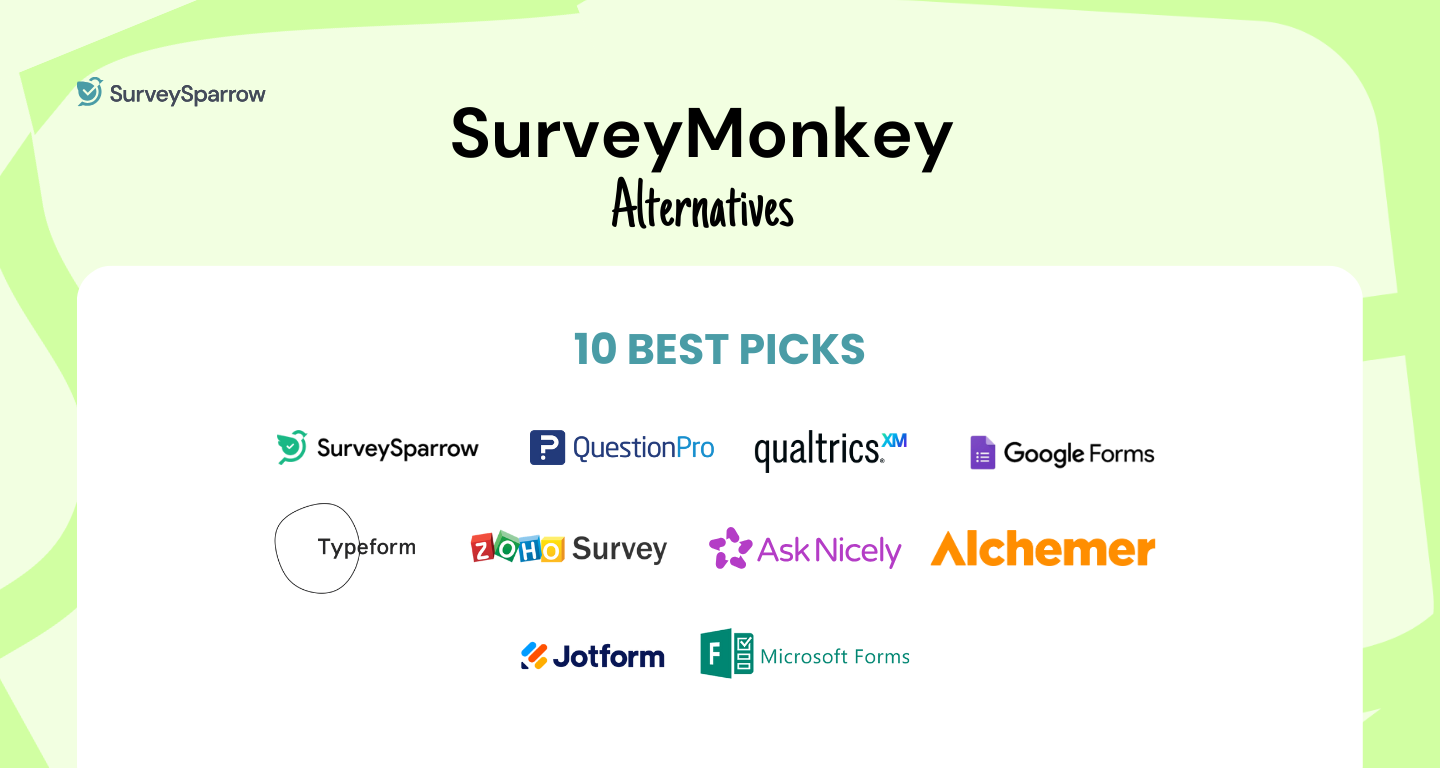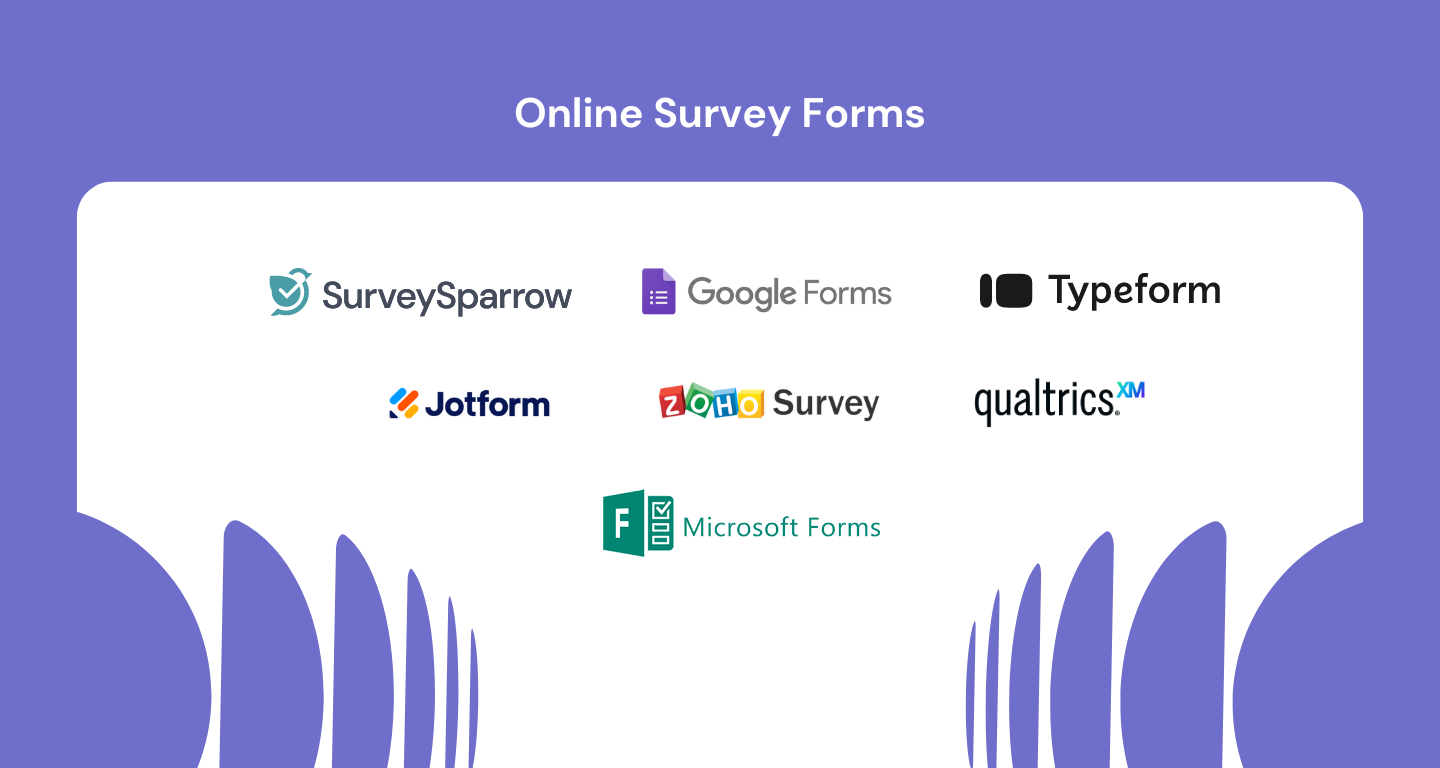Hey there! If you’re looking for a way to gather feedback, understand your customers, or just collect information, online survey forms are your best friend. I’ve tried and tested many survey form makers, and I’m here to share everything you need to know about them. By the end of this guide, you’ll have all the details to choose the perfect online survey form software without needing to look elsewhere.
Category: Surveys Page 1 of 6

A few years ago, I ran affiliate campaigns for a few ClickBank products through paid and organic SEO.
Before getting into why I stopped working with ClickBank products to promote as an affiliate, I would like to explain how affiliates can make a good income through promoting software products.

You’ve probably heard of SurveyMonkey, a popular tool for creating surveys, but what if it’s not quite what you’re looking for? Maybe you’re on a tight budget, need more advanced features, or just want a different look and feel.
In that case, SurveyMonkey alternatives come in handy! There are plenty of great survey tools out there, each with its unique strengths.
Our aim is to help you find the perfect match for your needs. To begin with, in this guide, we’ll explore some of the best SurveyMonkey competitors out there. Now, let’s go over each tool in detail.
SurveySparrow: For engaging, conversational surveys that drive higher response rates & richer insights

SurveySparrow is more than just a survey tool. It’s a platform designed to make feedback collection as engaging and insightful as possible. Furthermore, its emphasis on conversational interfaces, coupled with robust features and excellent customer service, makes it a compelling choice for anyone looking to gather feedback efficiently and effectively. Where does SurveySparrow score?
- SurveySparrow offers engaging dashboards and insights, enabling intuitive and powerful data visualization
- It comes with a comprehensive library of more than 1000+ survey templates
- The tool is versatile as it can get. So whether you’re conducting Net Promoter Score (NPS) surveys, CSAT surveys, or need a chatbot for your website, SurveySparrow has you covered.
- With a variety of plans tailored to suit different needs, SurveySparrow offers great value. Plus, there’s a Forever Free Plan for those just starting out.
- SurveySparrow’s commitment to its users is evident in its responsive and helpful customer support team
- The tool lets users create surveys in seconds using AI survey builder. Tell your intent through a prompt, and your personalized survey will be ready.
Limitations
While SurveySparrow excels in user experience and design, those needing highly specialized data analysis tools might find it less comprehensive than some of the more research-focused platforms.
Ideal for
SurveySparrow is perfect for businesses of all sizes that value user experience and engagement. Its approachable interface makes it particularly suitable for customer feedback, product experience, and market research where higher response rates are desired.
Pricing: Starts at $19 per month. With ten different plans, ranging from Basic to Platform, SurveySparrow offers a variety of options to fit different needs.
QuestionPro: For academic researchers to market analysts

QuestionPro offers a user-friendly and robust alternative to SurveyMonkey, appealing to both novices and experts with its easy interface and comprehensive support Where does QuestionPro score?
- One of QuestionPro’s most compelling features is the ability to conduct unlimited surveys with unlimited responses, even on the free plan. This is especially beneficial for projects requiring extensive data collection.
- It offers advanced question types such as conjoint analysis and max diff, QuestionPro allows for more sophisticated survey designs that can provide deeper insights than standard survey questions.
- Available 24/7 via live chat and email, the support team is well-versed in the platform, ensuring users have the assistance they need, when they need it.
Limitations
While QuestionPro scores high on usability and support, some users have raised concerns about inconsistent pricing and challenges with specific integrations, which could be a consideration for those with complex needs.
Ideal for
With its versatile features, QuestionPro is suitable for a broad spectrum of users, from solo practitioners to large enterprises. It’s particularly favored in sectors like nonprofit management, education, civic organizations, health and wellness, and market research.
Pricing: Advanced plan starts at $85 per month. Free version available.
Qualtrics: For organizations & researchers who need a powerful, scalable solution for complex projects

Qualtrics stands out as a comprehensive platform for those looking for deep insights into customer, employee, product, and brand experiences. Indeed, its sophisticated environment distinguishes it as a top SurveyMonkey alternative for complex survey requirements. Where does Qualtrics score?
- Qualtrics goes beyond simple surveys, offering tools to capture, analyze, and act on data across various aspects of business and research. It’s designed to handle complex scenarios and deliver actionable insights.
- With powerful analytics and reporting capabilities, Qualtrics makes it easy to dive deep into your data. It offers advanced statistical analysis, predictive intelligence, and automated insights to help you understand the nuances of your data.
- From survey design to data collection, Qualtrics provides a high level of customization. Tailor your surveys with advanced logic, branching, and triggers to ensure you’re asking the right questions at the right time.
Limitations
What’s the catch Qualtrics’ advanced features come with a steeper learning curve and a higher price tag, making it potentially daunting for new users or smaller organizations with limited budgets.
Ideal For
It’s particularly suited for large enterprises, academic research, and any organization that requires sophisticated data collection and analysis capabilities. Qualtrics caters to those who need to conduct in-depth market research, employee engagement studies, and customer satisfaction surveys.
Pricing: For specific pricing, contact to get a quote.
Google Forms: The Go-To Tool for Simple Surveys

Google Forms might be simple, but sometimes simple is all you need. It is a go-to solution for many when it comes to creating forms and quizzes. This tool stands as a straightforward solution for many, prized for its ease of use and no-frills design, particularly appealing for those stepping away from SurveyMonkey’s complexity. Where does Google Forms score
- Google Forms lets you and your team work on surveys together in real-time. This is a game changer for group projects, where everyone can contribute simultaneously.
- If you’re already using Google Workspace, integrating Forms with Sheets or Drive is a breeze. This makes organizing and analyzing your data simple and efficient.
- You won’t hit a cap on how many surveys you can create or how many responses you can collect. This is a significant advantage over some of SurveyMonkey’s limitations on its free plan.
What’s the catch? The simplicity that makes it accessible means it lacks deeper data analysis tools, automation features, and the ability to manage responses in more sophisticated ways. This might leave professionals and corporations wanting more. Who will love Google Forms? It’s perfect for educators, small to medium-sized businesses, and anyone who needs to gather data quickly and without fuss. You can easily move your data to spreadsheets for further analysis, making it a handy tool for researchers and analysts too.
Pricing: Free.
Typeform: Accessible & Beautiful: SurveyMonkey Alternatives for Nonprofits

Typeform redefines the survey experience with its emphasis on design and user engagement. Known for its sleek interface and interactive elements, it stands as a vibrant alternative for creating surveys, quizzes, and forms. Why Typeform?
- Typeform’s standout feature is its beautiful, minimalist design that makes every interaction feel more personal and engaging.
- Typeform boasts a smooth, conversational flow. This approach keeps respondents engaged from start to finish, leading to higher completion rates.
- With Typeform, you can easily customize your forms to match your brand’s style. Plus, its wide range of question types and logic jumps allows for tailored survey paths that feel more relevant to each respondent.
Limitations
While Typeform’s design-focused approach is its strength, it may not offer the depth of analytics and advanced survey features that some users, particularly researchers or large enterprises, might need.
Ideal For
Typeform is a great choice for businesses and individuals who prioritize aesthetics and user experience. It’s particularly well-suited for marketing, customer feedback, event planning, and any scenario where engaging the audience is key.
Pricing: Starts at $25
Zoho Surveys: For user-friendliness and affordability

Zoho Survey finds a sweet spot between functionality and user-friendliness, offering a compelling choice for those seeking a balance between features and ease of use. Why Zoho Survey?
- If you’re already in the Zoho ecosystem, Zoho Survey will feel like home. It integrates perfectly with other Zoho tools, offering a smooth, unified experience.
- Zoho Survey presents competitive pricing plans that won’t break the bank, making it an attractive option for small businesses and individual users alike.
- Need people to take your survey? Zoho Survey provides access to Zoho’s own respondent panel, making it easier to gather the data you need.
Limitations
The survey logic can be basic and confusing for some users, and the interface, while functional, may not win any design awards.
Ideal For
Zoho Survey shines across various sectors like HR, education, healthcare, business, and more, thanks to its multilingual capabilities. It’s especially useful for those already using other Zoho products.
Pricing: Starts at $20 per month.
AskNicely: For those prioritizing NPS as a key metric for customer satisfaction

AskNicely is a powerful, focused tool for businesses serious about understanding and improving their Net Promoter Score, offering simplicity and efficiency in customer feedback management. Where does AskNicely score?
- Designed from the ground up for NPS, AskNicely provides specialized workflows to measure and improve your Net Promoter Score effectively, a stark contrast to the broader approach of SurveyMonkey.
- It allows for immediate notification and feedback, making it possible for businesses to quickly act on customer insights, address concerns, and boost engagement.
- AskNicely excels in delivering in-depth reporting and analytics that are tailored to understanding customer behavior and loyalty, featuring customizable dashboards and advanced segmentation.
Limitations
The platform’s multi-brand and template features can be somewhat limited and not as intuitive, and there have been mentions of minor bugs within its mobile application affecting data accuracy.
Ideal For
It’s particularly beneficial for service-based and home service companies looking to collect real-time feedback to improve service quality, customer retention, and, ultimately, revenue.
Pricing: Request for a Quotation.
Alchemer: For complex research projects and in-depth market analysis

Alchemer positions itself as a dynamic survey platform that goes beyond mere questionnaires to deliver powerful, actionable insights. With emphasis on customization and integration, Alchemer suits those who seek depth in their data collection efforts. Why Alchemer?
- Users can tailor almost every aspect of their surveys, from the look and feel to the logic and flow, ensuring that each survey perfectly aligns with their objectives.
- The platform excels in seamlessly integrating with a wide range of tools and systems, including CRM, analytics, and marketing platforms. This integration ensures that data flows smoothly across your tools, enhancing the overall utility of the insights gathered.
- Alchemer goes beyond simple surveys with advanced features such as sentiment analysis, data analysis tools, and enhanced security options, making it a powerhouse for those who need to dig deeper into their data.
Limitations
The platform’s breadth and depth, while impressive, can present a steep learning curve for new users. Additionally, the most powerful features come at a higher price point, which might not fit all budgets.
Ideal For
Alchemer is particularly well-suited for businesses, researchers, and professionals who require detailed feedback mechanisms and have specific needs that standard survey tools can’t meet. Its advanced features make it ideal for complex research projects and in-depth market analysis.
Pricing: Contact to get a quote
Jotform: When you want to tackle a wide range of tasks with minimal fuss

JotForm is a flexible and user-friendly platform that excels in creating forms for various purposes, from simple contact forms to complex surveys and registrations. Its adaptability and ease of use make it a preferred choice for individuals and businesses alike. Why JotForm?
- One of JotForm’s main attractions is its straightforward drag-and-drop interface, making form creation accessible to users of all skill levels without requiring any coding knowledge.
- With thousands of templates available, JotForm offers a head start on form design, allowing users to find and customize the perfect template for their needs quickly.
- JotForm integrates with a wide array of services, including payment processors like PayPal and Stripe, email marketing tools, and cloud storage solutions, facilitating a seamless workflow.
- Beyond its ease of use, JotForm provides advanced customization options, enabling users to create forms that perfectly match their branding and specific requirements.
Limitations
While JotForm is highly versatile, users with very specific or advanced data analysis needs might find its reporting and analytics features less comprehensive compared to more specialized survey platforms.
Ideal for
JotForm is well-suited for businesses, educators, and nonprofits seeking a reliable form builder for various applications, from gathering feedback and conducting surveys to event registration and collecting payments.
Pricing: Starts at $24 per month.
Microsoft Forms: For creating simple surveys, quizzes, and polls

Being part of the Microsoft 365 suite makes it a seamless choice for users already embedded in Microsoft’s ecosystem. With its simple interface and essential features, Microsoft Forms caters to educators, businesses, and individuals who need to gather information efficiently. Why Microsoft Forms?
- The tool stands out for its intuitive design, allowing anyone to create and share forms quickly without a steep learning curve.
- If you’re using Office 365, Microsoft Forms integrates smoothly with other Microsoft apps like Excel, making data analysis straightforward. This connectivity enhances productivity and data management.
- As responses come in, you can view data in real-time, enabling immediate insights and decisions. This feature is particularly useful for educators and teams needing quick feedback.
The Limitations
While Microsoft Forms is excellent for basic survey needs, its simplicity might be a limitation for users requiring advanced survey functionalities, such as complex branching logic or in-depth analytics.
Ideal for
Microsoft Forms is ideal for educators conducting quizzes, businesses gathering customer feedback, or any Office 365 user looking to create straightforward, no-frills surveys. It’s also great for event planning, internal employee feedback, and quick polls.
Pricing: Free

Surveys are a valuable tool for gathering insights, opinions, and feedback from your target audience.
Whether you’re a business looking to improve customer satisfaction or a researcher conducting academic studies, getting a high survey response rate is crucial for obtaining meaningful and representative data.

In the realm of data collection and market research, the significance of high survey response rates cannot be overstated.
These rates not only reflect the effectiveness of your survey strategy but also ensure the reliability and validity of the data collected.

Introduction
Hello there! Today, we’re diving into a super interesting topic for anyone looking to boost their brand through influencer marketing: the top 10 email outreach tools. Why email, you ask? It’s a fantastic way to get in touch with influencers and get your brand noticed. But it’s not just about sending any email; it’s about sending the right email. And for that, you need the right tools.

In the ever-evolving world of blogging, creating captivating and high-quality content is key to attracting and retaining an audience. With an array of free and paid content creation tools at their disposal, bloggers can significantly enhance their content’s appeal and effectiveness. This blog post will introduce you to 20 such tools, essential for anyone looking to streamline their content creation process.

In the dynamic world of digital marketing, staying ahead in the SEO game is crucial. The backbone of any successful SEO strategy is efficient keyword research, which helps in understanding what your audience is searching for. This blog post will introduce you to the 10 most effective keyword research tools, essential for anyone looking to boost their online presence.

Introduction
In today’s fast-paced world, staying ahead in your professional and personal life can be a daunting task. That’s where the power of productivity tools comes in. As a seasoned blog writer with over a decade of experience in exploring and recommending the best in tech, I’ve witnessed firsthand how the right tools can revolutionize your efficiency and output. This blog dives into 20 exceptional productivity tools designed to help you get more done in less time. Whether you’re juggling multiple projects, managing a team, or just looking to streamline your daily tasks, these tools are your allies in achieving more with less effort. Let’s embark on this journey to unlock the full potential of your productivity!
20 Productivity Tools that Ease Your Work
Trello:
Trello uses a board-based system where you create lists (representing different stages of a project) and cards (tasks or items). It’s ideal for visualizing project flow and collaborating with team members. You can assign tasks, set deadlines, and add comments or attachments.
Asana:
Asana is a task and project management tool that helps teams organize, track, and manage their work. It allows you to create projects, assign tasks to team members, set deadlines, and track progress through various views like lists, boards, and timelines.
Slack:
Slack is a communication platform designed for teams. It offers features like direct messaging, channels for different topics or teams, file sharing, and integration with other tools. It’s effective for reducing email clutter and keeping all team communications in one place.
Evernote:
Evernote is a note-taking app that lets you capture, organize, and find your notes across all devices. It’s great for storing meeting notes, web pages, project ideas, and to-do lists. Its powerful search and tag system makes retrieving information quick and easy.
Zoom:
Zoom is a video conferencing tool that has become essential for remote meetings and webinars. It offers features like screen sharing, breakout rooms, and recording options. It’s known for its reliability and ease of use.
Google Workspace:
Google Workspace (formerly G Suite) includes apps like Gmail, Google Drive, Docs, Sheets, and Slides. It’s designed for collaboration, allowing multiple users to work on documents simultaneously and share files easily.
Microsoft 365:
Microsoft 365 offers a suite of office tools including Word, Excel, PowerPoint, Outlook, and OneDrive. It’s a staple for document creation and management, offering robust features for all types of professional work.
Todoist:
Todoist is a task management application that helps you organize and prioritize your personal and professional tasks. It features setting due dates, reminders, and categorizing tasks with labels and projects.
Notion:
Notion is an all-in-one workspace where you can write, plan, collaborate, and get organized. It combines notes, tasks, wikis, and databases to provide a flexible way of organizing information.
Airtable:
Airtable is a cloud-based tool that combines features of a database with the simplicity of a spreadsheet. It’s used for organizing projects, customer relationship management (CRM), event planning, and more.
Dropbox:
Dropbox is a file hosting service that offers cloud storage, file synchronization, personal cloud, and client software. It’s particularly useful for sharing large files and collaborating on documents.
LastPass:
LastPass is a password manager that stores encrypted passwords online. It helps in generating strong passwords and securely sharing them, ensuring you don’t have to remember multiple complex passwords.
RescueTime:
RescueTime is a time management tool that tracks the time spent on applications and websites, giving you an accurate picture of your day. It helps in identifying productivity leaks and provides detailed reports.
Focus@Will:
Focus@Will offers various music channels scientifically optimized to increase concentration and productivity. It can be a great aid for those who find background music helpful for their workflow.
Hootsuite:
Hootsuite is a social media management platform that allows you to schedule posts, track social media performance, and manage all your social media accounts from one dashboard.
Grammarly:
Grammarly is a writing tool that helps you check for grammatical errors, typos, and sentence structure. It integrates with various platforms, making it easier to maintain professionalism in writing.
MindMeister:
MindMeister is an online mind mapping tool that allows you to visually organize information. It’s great for brainstorming, planning projects, and creating presentations.
Canva:
Canva is a graphic design platform that provides access to millions of graphics, templates, and fonts. It simplifies the design process for non-designers.
Buffer:
Buffer is a social media management tool that helps in planning, scheduling, and publishing content across social networks. It also provides analytics to track engagement and performance.
IFTTT (If This Then That):
IFTTT is a web-based service that creates chains of simple conditional statements, called applets. These applets automate tasks between two or more services (like turning off your lights when you leave the house, based on your phone’s location).
Each of these tools offers unique features to streamline your workload, enhance collaboration, and boost productivity in various aspects of professional and personal life.
How to Use These Tools Effectively
Using productivity tools effectively involves more than just installing them; it’s about integrating them into your workflow in a way that amplifies your efficiency. Here’s how to make the most of these tools:
Identify Your Needs:
Before diving into any tool, clearly understand what you need. Is it task management, team collaboration, time tracking, or something else? Choose tools that specifically address these needs.
Integrate Tools into Daily Routines:
Once you’ve selected your tools, incorporate them into your daily routines. For instance, start your day by checking Todoist for your tasks, use Trello or Asana to manage projects, and Slack for team communications.
Simplify, Don’t Complicate:
The goal is to simplify your work process. Avoid tool overload; using too many tools can lead to confusion and decreased productivity.
Leverage Tutorials and Training:
Most of these tools come with tutorials, webinars, and community forums. Utilize these resources to get the most out of each tool.
Regularly Review and Adapt:
Periodically review the effectiveness of each tool. Be flexible and ready to adapt your toolset as your needs or the nature of your work changes.
Automate Repetitive Tasks:
Use tools like IFTTT to automate repetitive tasks. This can save you a significant amount of time and reduce the chances of human error.
Collaborate and Share:
Tools like Google Workspace, Dropbox, and Asana are excellent for collaboration. Share documents, feedback, and progress with your team in real time.
Secure Your Data:
With tools like LastPass, ensure that your passwords and sensitive information are securely managed.
Balance Technology with Human Interaction:
While tools like Zoom are great for virtual meetings, remember the importance of face-to-face interaction (where possible) for team dynamics and relationship building.
Track and Analyze Performance:
Use time-tracking tools like RescueTime to analyze how you spend your day and make informed decisions to improve your productivity.
Conclusion
In the quest for higher productivity and efficiency, the right tools can make all the difference. From task management with Asana and Todoist to team collaboration through Slack and Zoom, each tool offers unique advantages that can help streamline your workflow and save precious time. However, the real key to productivity lies not just in the tools you use but in how effectively you use them. Integrating these tools into your daily routine, adapting them to your specific needs, and continuously evaluating their impact on your work will enable you to work smarter, not harder. By strategically leveraging these 20 productivity tools, you’re setting yourself up for success, enabling you to achieve more in less time with less effort. Remember, in the modern work environment, efficiency is king, and with these tools at your disposal, you’re well-equipped to claim your throne.

Survey fatigue is a growing concern in today’s data-driven world, where organizations and researchers rely heavily on surveys to gather valuable insights. This phenomenon occurs when survey respondents become overwhelmed, disinterested, or frustrated with the sheer volume and repetitiveness of surveys they encounter in their daily lives. As a result, it leads to declining response rates and, more importantly, compromised data quality. In this blog post, we will delve into the intricacies of survey fatigue, exploring its causes, consequences, and most importantly, effective strategies to prevent it. Whether you are a business aiming to understand your customers better or a researcher seeking to collect meaningful data, understanding and addressing survey fatigue is crucial to ensure the accuracy and relevance of your survey results.
Understanding Survey Fatigue
Survey fatigue is a phenomenon that can significantly impact the quality and reliability of data collected through surveys. It occurs when individuals are subjected to an excessive number of surveys, causing them to become disengaged and less willing to provide thoughtful and accurate responses. One of the primary causes of survey fatigue is the sheer volume of surveys people encounter in various aspects of their lives, from customer satisfaction surveys to market research questionnaires. Additionally, poorly designed surveys with lengthy, complex, or repetitive questions can exacerbate this issue. Understanding survey fatigue is crucial for businesses, researchers, and organizations, as it can lead to skewed data, decreased response rates, and compromised decision-making. In this section, we will delve deeper into the factors that contribute to survey fatigue, shedding light on why it’s imperative to address this issue in survey design and implementation.
Consequences of Survey Fatigue
The consequences of survey fatigue are far-reaching and can have a profound impact on the quality and utility of the data collected. First and foremost, survey fatigue can result in significantly lower response rates. When individuals are bombarded with surveys or confronted with overly lengthy and tedious questionnaires, they are more likely to abandon the survey altogether or provide rushed, thoughtless responses. This, in turn, can introduce a bias in the data, as those who do respond may not be representative of the entire population being surveyed.
Moreover, survey fatigue can undermine the reliability and accuracy of the information obtained. Respondents who are fatigued may skip questions, provide inconsistent answers, or even resort to providing false information to expedite the survey completion process. For businesses and researchers, this means that the insights derived from such data become less trustworthy, making it challenging to make informed decisions or draw meaningful conclusions. As such, the consequences of survey fatigue extend beyond just reduced response rates; they impact the integrity and utility of the data collected, ultimately affecting the quality of decision-making and research outcomes. In the next section, we will explore the common causes of survey fatigue, shedding light on the factors that contribute to this prevalent issue in survey research.
Common Causes of Survey Fatigue
Survey fatigue can be attributed to a variety of common causes, each of which contributes to the weariness and disinterest experienced by respondents. One primary cause is the excessive length of surveys. When surveys are overly lengthy, respondents may become frustrated and lose patience, causing them to rush through the questions or abandon the survey altogether. Another factor is the frequency of surveys; individuals who are repeatedly asked to participate in surveys may start to feel overwhelmed and less willing to engage. Additionally, poorly designed surveys with complex or redundant questions can be a significant source of fatigue, as respondents struggle to decipher confusing inquiries or grow tired of answering similar questions repeatedly. Understanding these common causes is essential for crafting surveys that are engaging, efficient, and respectful of respondents’ time, ultimately helping to mitigate survey fatigue and maintain data quality.
Preventing Survey Fatigue
Preventing survey fatigue is essential for ensuring that respondents remain engaged and provide high-quality, meaningful responses. One key strategy is thoughtful survey design. This includes keeping surveys concise and focused, avoiding unnecessary or repetitive questions, and structuring questions in a clear and user-friendly manner. Personalization also plays a crucial role; tailoring surveys to individual respondents based on their previous interactions or characteristics can make the experience more engaging. Furthermore, organizations and researchers should be mindful of the timing and frequency of their survey requests, ensuring that they do not overwhelm respondents. Employing technology solutions such as skip logic and branching, which adapt the survey flow based on previous responses, can enhance the overall survey experience. By implementing these strategies and respecting respondents’ time and preferences, survey fatigue can be effectively prevented, resulting in more reliable and valuable data collection.
Using Technology to Combat Survey Fatigue
Leveraging technology is a powerful way to combat survey fatigue and enhance the overall survey experience. One of the key technological solutions is the use of advanced survey software and platforms. These tools offer features like skip logic, which tailors the survey path based on respondents’ previous answers, allowing for a more personalized and efficient survey experience. Additionally, they enable the automation of reminders and follow-up emails, reducing the burden on survey administrators while gently prompting respondents to participate. Furthermore, advanced analytics and reporting capabilities provided by these platforms allow for real-time monitoring of survey responses, enabling organizations to identify and address any issues related to fatigue promptly.
Another technological approach is the use of artificial intelligence (AI) and machine learning. AI can be employed to analyze respondents’ behavior and preferences, helping to optimize the survey design and content for individual users. It can also assist in predicting when a respondent may be experiencing fatigue and adjust the survey flow accordingly. Moreover, AI-driven chatbots and virtual assistants can offer a more conversational and user-friendly survey experience, making respondents feel more engaged and less fatigued. Overall, technology plays a pivotal role in combating survey fatigue by automating processes, personalizing surveys, and improving user interactions, ultimately leading to higher response rates and better data quality.
Best Practices for Effective Surveys
Creating effective surveys is crucial for obtaining high-quality data and meaningful insights. Here are some best practices to follow when designing surveys:
Define Clear Objectives: Start by clearly defining the goals and objectives of your survey. What specific information or insights are you trying to gather? Having a clear purpose will guide your survey design.
Keep Surveys Concise: Long surveys can lead to survey fatigue and reduced response rates. Keep your surveys as short and focused as possible, only including questions that are directly relevant to your objectives.
Use Clear and Simple Language: Write questions using plain language that your target audience can easily understand. Avoid jargon, technical terms, or complex language that may confuse respondents.
Avoid Double-Barreled Questions: Each question should address a single topic or issue. Avoid combining multiple questions into one, as it can lead to unclear responses.
Avoid Leading Questions: Ensure that your questions are neutral and unbiased. Avoid wording that may lead respondents to answer in a certain way or express a particular opinion.
Include a Mix of Question Types: Use a variety of question types, including multiple-choice, open-ended, rating scales, and yes/no questions, to gather different types of data and insights.
Prioritize Important Questions: Place your most important questions at the beginning of the survey to capture respondents’ attention and ensure they are answered even if respondents don’t complete the entire survey.
Use Logical Flow: Organize your questions in a logical order. Start with easy, non-sensitive questions to build rapport before moving to more complex or personal topics.
Offer Response Options: Provide appropriate response options for each question. Ensure that all possible answer choices are covered to avoid respondents feeling forced into selecting an irrelevant option.
Use Skip Logic: Implement skip logic to tailor the survey experience to individual respondents. This helps reduce unnecessary questions and keeps the survey relevant to each respondent.
Test Your Survey: Before deploying your survey, test it with a small group of people to identify any issues with question wording, survey flow, or technical glitches.
Ensure Mobile Compatibility: With the increasing use of mobile devices, make sure your survey is mobile-friendly and responsive for respondents taking it on smartphones or tablets.
Offer Anonymity and Privacy: Assure respondents that their responses will remain confidential and that their personal information will not be shared or used for any other purpose.
Provide Progress Indicators: If your survey is longer, include progress indicators so respondents know how much more time is required to complete it.
Pilot Surveys: Run pilot surveys with a small sample of your target audience to identify any potential issues or areas for improvement before launching the full survey.
Follow Up and Thank Respondents: After the survey is completed, send a thank-you message or follow-up to show appreciation for their participation.
Wrapping Up
In conclusion, designing effective surveys is a crucial skill for businesses, researchers, and organizations seeking to gather valuable insights and make informed decisions. By adhering to best practices such as setting clear objectives, using clear and concise language, and respecting respondents’ time and privacy, you can maximize the quality of the data you collect and minimize survey fatigue. Additionally, leveraging technology, such as advanced survey software and AI-driven solutions, can enhance the survey experience and improve engagement. Remember that a well-designed survey not only yields reliable data but also respects the valuable time and input of your respondents, fostering goodwill and potentially increasing the likelihood of future participation.


